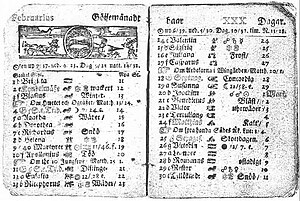February 30
TheFebruary 30or30 Februarydoesn't exist in both Julian and Gregorian calendar. The month February has only 28 days (29 days in a leap year).
Real life
[change|change source]February 30 was a real date in few calendars.[1]
Early Julian calendar
[change|change source]Johannes de Sacroboscoclaimed that from 45 BC to 8 BC, the February had 30 days in leap year. In 8 BC,Augustusadded 31 days in August. It made the February shorter.
Swedish calendar
[change|change source]
In 1700, Sweden tried to change theirJulian calendardate toGregorian calendardate by removing allleap yearsfrom 1700. However, the 1704 and 1708 became leap days by mistake. So Sweden added 2 leap days in February 1712 to match their dates with the Julian calendar. They changed to Gregorian calendar in 1753 by removing the 11 days from February.
Soviet calendar
[change|change source]Many sources claimed that from 1929 to 1940, the Soviet Union used a new calendar. It had 5-6 weeks and 30 days each month. Other 5 days were holidays in the calendar, just like theFrench Republican Calendar.
Fictional calendars
[change|change source]InJ. R. R. Tolkien'sMiddle-earthlegendarium,theHobbitshave developed theShire Reckoning.
According to Appendix D toThe Lord of the Rings,this calendar has 12 months and 360 days. The month the Hobbits callSolmathactually saysFebruaryin the text. The month shows 30 days.[2]
February 30, 1951, is the last night of the world inRay Bradbury's short story, "Last Night of the World".[3]
References
[change|change source]- ↑"February 30 Was a Real Date".
- ↑Tolkien, J. R. R. (1965). "Appendix D".The Return of the King(2nd ed.). Boston: Houghton Mifflin Co.ISBN978-0-395-08256-0.
- ↑"A Classic Ray Bradbury Esquire Story".esquire.com.6 June 2012.Retrieved21 March2017.
